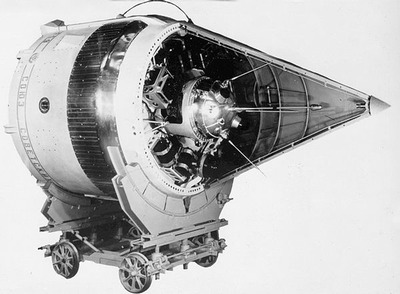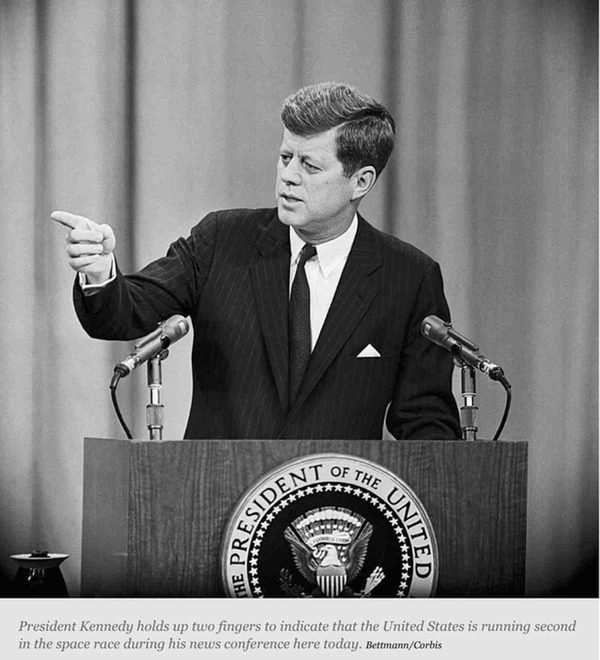
In space no one can hear you sighby Dwayne A. Day
|
| Take a look at the caption for the article’s photo of President Kennedy that says Kennedy is holding up two fingers, while in the photo right above it he’s holding up only one. |
Kurt Eichenwald’s article, which has the title “The Plan to Nuke the Moon and Other Cold War Plots Revealed in Secret Documents,” is about various Cold War space events, mostly from the 1940s to the early 1960s. The angle that Eichenwald has chosen is that the Cold War Space Race was a time when American military and intelligence officials came up with goofy, off-the-wall ideas. The cover art sets the tone, showing Yuri Gagarin surrounded by a circus of scribblings.
Eichenwald starts with a rather breathless account of the time that the CIA “kidnapped” a Soviet lunar spacecraft that was being transported from a science exposition and closely examined it before releasing it without the Soviets being any wiser. Even if you are not very familiar with the subject matter, a careful reading of the article will leave you wondering if an editor ever looked at it. For instance, in the second paragraph the author refers to “a Lunik space vehicle” and only one sentence later refers to it as a “missile.” Which was it, space vehicle or missile? Does the reporter know the difference? In actuality, it was a propulsion stage that sent early Soviet lunar spacecraft towards the Moon. (And lest you think this is an isolated incident of a Newsweek editor being asleep on the job, take a look at the caption for the article’s photo of President Kennedy that says Kennedy is holding up two fingers, while in the photo right above it he’s holding up only one.)
 This upper stage, minus the small Luna 1 spacecraft inside the shroud, is what the CIA examined during its intelligence operation mentioned in the Newsweek article. |
But this awkwardly-worded sentence also has some bigger problems:
The “kidnapping” of that missile, done without the Soviets ever knowing about it, is one of many wild and sometimes weird secret operations and schemes exposed for the first time in a series of recently declassified government documents concerning the so-called Space Race, which was feared to be important for military reasons but known to be propaganda that could swell national pride.
The author’s claim that these “weird secret operations and schemes” are “exposed for the first time in… recently declassified government documents” is flat out wrong. All of the incidents discussed in the Newsweek article have appeared in print before, sometimes decades ago. The first public account of the “kidnapping” incident was in 1996—by me. My article was based upon a piece written by intelligence official Sydney Wesley Finer and published in a secret CIA in-house journal in 1967. Finer’s article was declassified in 1995 and deposited in the National Archives, where I found it and later wrote about it, both in Quest and Spaceflight magazines. Other authors have since cited my articles as well as the original Finer article. A simple web search would have turned up some of those facts, and a phone call to a couple of space historians could have turned up the rest. What some searching also would have revealed was that there was no such thing as a “Lunik.” It’s a made-up word. Eichenwald never realized that.
| The author seems to conclude that because he didn’t know about these things before now, they must be new. But there’s really nothing in the article that hasn’t been published before. |
After writing about the incident in the mid-1990s, over the years I gathered bits and pieces of additional information. Although Finer never mentioned where this intelligence operation happened, I learned that the CIA examination of the spacecraft occurred in Mexico after the spacecraft propulsion stage, minus its engine, was displayed in Mexico City. The CIA had conducted an earlier assessment when it had visited Paris and that’s how they knew it was genuine and began planning a more detailed examination. Although the engine was missing, the CIA swabbed the insides of the spacecraft to obtain propellant residue. Several years ago one of the Mexican intelligence agents involved in the operation gave an interview on a local television news program in California where he now lives. I contacted his family to see if he was willing to give a more extensive interview, but was informed that he was trying to sell a book about his exploits and was unwilling to talk to me.
 The caption and photo from the Newsweek story don’t match. |
But if anybody deserves credit in the Newsweek article it is Jeff Richelson of the National Security Archive at the George Washington University who put together the document collection that Eichenwald refers to. Richelson is not mentioned at all, and the author did not bother to contact him. Nor did he bother to contact any other space historian, such as Jim Oberg, who could have told him what was and was not a newly revealed bit of information about this era. For example, the article refers to Project Horizon, an Army moonbase study, as if it is also only recently-declassified. But Horizon has been known for decades and written about in numerous books. The same is true for the 1958 proposal to detonate a nuclear bomb on the Moon, a story that reporters seem to breathlessly discover “for the first time” over and over and over again. (here in 2012, and here in 2000, and apparently first exposed here in 1999).
The author seems to conclude that because he didn’t know about these things before now, they must be new. But there’s really nothing in the article that hasn’t been published before. The collection of documents that Richelson put together add details to the subjects, but the main events have been known for years, if not decades.
There have been other recently declassified documents and materials that have broken new ground about the Cold War Space Race. See, for instance, the MOL and UPWARD documents released by the National Reconnaissance Office this summer. There are some fascinating revelations in there, such as the plan to use a top secret spy satellite camera to scout out lunar landing sites during Apollo, or discussions of having a manned spy satellite take images of Mars and other planets. Other historians, like Anatoly Zak and Asif Siddiqi, have revealed fascinating details of Soviet space activities during the height of the Cold War. Earlier this year I wrote about how American satellites spotted the exploded remains of a 1983 Soviet manned spacecraft launch, and just this month I published an article about the time in 1968 when American satellite operators grew concerned that the Soviets might be planning on shooting down an American spysat.
| I’m exasperated and tired of what seems to pass for space history in the popular press these days—and the total lack of editorial oversight. |
Perhaps the biggest problem with the Newsweek article is not the mistaken belief that the material it contains is new, but its overall tone about the crazy history of the Space Race and the goofballs who ran it, particularly on the American side. After discussing a 1958 American nuke-the-Moon proposal, Eichenwald wrote: “While the United States was involved in these mushroom-cloud-in-the-sky schemes, the Soviets were developing plans that made more sense” and he then recounts Soviet efforts to send missions to Venus and Mars. Nutty Americans, sensible Soviets. Okay, sure. But if he had only done a little bit of research (like, say, heading over to Wikipedia), with a few mouse clicks he would have discovered that in 1958 the Soviets also investigated a plan to nuke the Moon. And it’s disingenuous to portray American military officials and scientists as chasing goofy plans while ignoring their work on ingenious spy satellites, miniaturized electronics, and increasingly powerful rockets.
Forgive me if it sounds like I’m annoyed. I’m not. I’m exasperated and tired of what seems to pass for space history in the popular press these days—and the total lack of editorial oversight. It’s all too common for reporters writing space history for the popular press to take intellectual and moral shortcuts in their work. Last year, Robert Kennedy and I published a detailed article demonstrating how reporter Amy Shira Teitel plagiarized numerous books and articles by other space historians such as Andy Chaikin and Bart Hendrickx (See: “Plagiarism in several space history articles,” The Space Review, November 4, 2013). One of the publications that ran her plagiarized articles, Ars Technica, immediately removed all of them. But the editors, perhaps worried about their jobs, or under advice of their lawyers, never apologized for their role in publishing articles that plagiarized the work of other authors. Neither did Ms. Teitel, who continues to write for Popular Science’s website as well as several other publications. Presumably her editors now regularly check Teitel’s articles for examples of plagiarism. But given what we can see from this Newsweek article, there are a lot of editors who aren’t paying the least bit of attention to what their writers are producing.